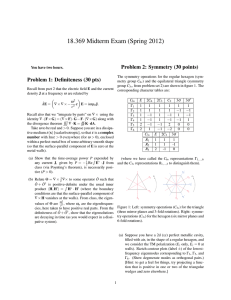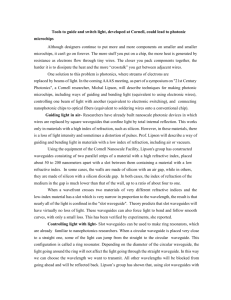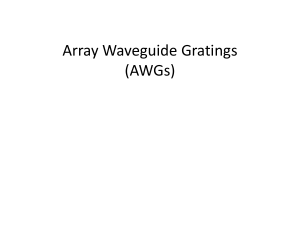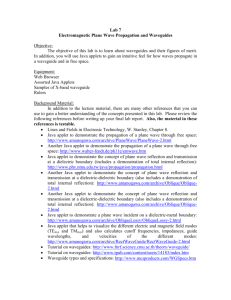Evanescent-wave bonding between optical waveguides Michelle L. Povinelli
advertisement
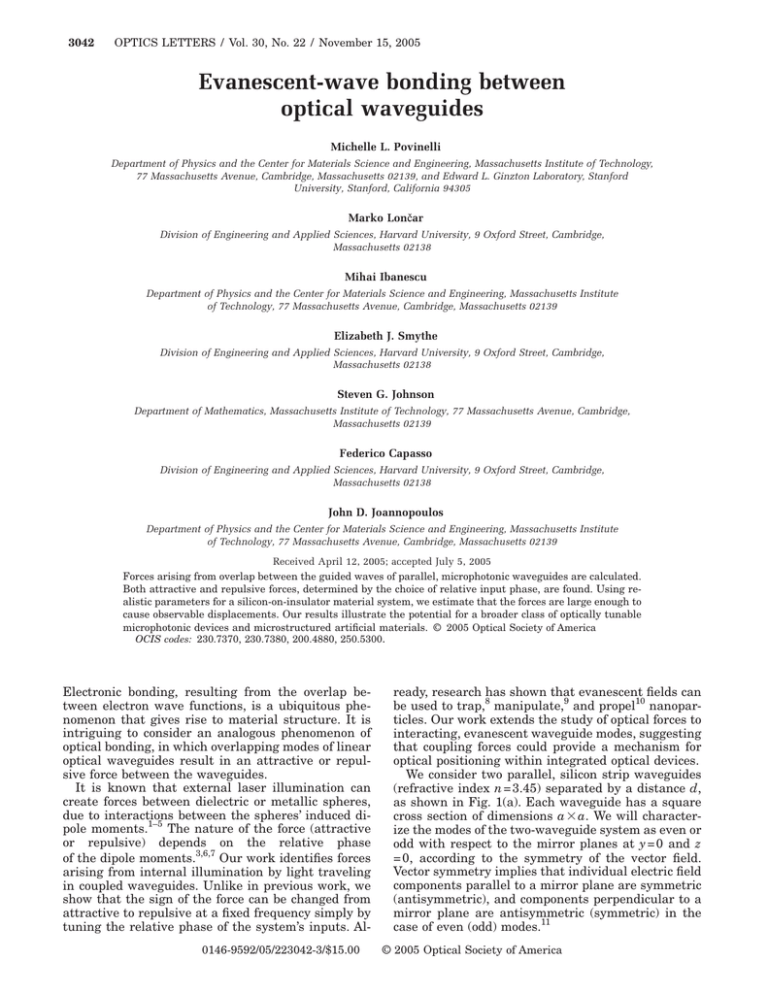
3042 OPTICS LETTERS / Vol. 30, No. 22 / November 15, 2005 Evanescent-wave bonding between optical waveguides Michelle L. Povinelli Department of Physics and the Center for Materials Science and Engineering, Massachusetts Institute of Technology, 77 Massachusetts Avenue, Cambridge, Massachusetts 02139, and Edward L. Ginzton Laboratory, Stanford University, Stanford, California 94305 Marko Lon~ar Division of Engineering and Applied Sciences, Harvard University, 9 Oxford Street, Cambridge, Massachusetts 02138 Mihai Ibanescu Department of Physics and the Center for Materials Science and Engineering, Massachusetts Institute of Technology, 77 Massachusetts Avenue, Cambridge, Massachusetts 02139 Elizabeth J. Smythe Division of Engineering and Applied Sciences, Harvard University, 9 Oxford Street, Cambridge, Massachusetts 02138 Steven G. Johnson Department of Mathematics, Massachusetts Institute of Technology, 77 Massachusetts Avenue, Cambridge, Massachusetts 02139 Federico Capasso Division of Engineering and Applied Sciences, Harvard University, 9 Oxford Street, Cambridge, Massachusetts 02138 John D. Joannopoulos Department of Physics and the Center for Materials Science and Engineering, Massachusetts Institute of Technology, 77 Massachusetts Avenue, Cambridge, Massachusetts 02139 Received April 12, 2005; accepted July 5, 2005 Forces arising from overlap between the guided waves of parallel, microphotonic waveguides are calculated. Both attractive and repulsive forces, determined by the choice of relative input phase, are found. Using realistic parameters for a silicon-on-insulator material system, we estimate that the forces are large enough to cause observable displacements. Our results illustrate the potential for a broader class of optically tunable microphotonic devices and microstructured artificial materials. © 2005 Optical Society of America OCIS codes: 230.7370, 230.7380, 200.4880, 250.5300. Electronic bonding, resulting from the overlap between electron wave functions, is a ubiquitous phenomenon that gives rise to material structure. It is intriguing to consider an analogous phenomenon of optical bonding, in which overlapping modes of linear optical waveguides result in an attractive or repulsive force between the waveguides. It is known that external laser illumination can create forces between dielectric or metallic spheres, due to interactions between the spheres’ induced dipole moments.1–5 The nature of the force (attractive or repulsive) depends on the relative phase of the dipole moments.3,6,7 Our work identifies forces arising from internal illumination by light traveling in coupled waveguides. Unlike in previous work, we show that the sign of the force can be changed from attractive to repulsive at a fixed frequency simply by tuning the relative phase of the system’s inputs. Al0146-9592/05/223042-3/$15.00 ready, research has shown that evanescent fields can be used to trap,8 manipulate,9 and propel10 nanoparticles. Our work extends the study of optical forces to interacting, evanescent waveguide modes, suggesting that coupling forces could provide a mechanism for optical positioning within integrated optical devices. We consider two parallel, silicon strip waveguides (refractive index n = 3.45) separated by a distance d, as shown in Fig. 1(a). Each waveguide has a square cross section of dimensions a ⫻ a. We will characterize the modes of the two-waveguide system as even or odd with respect to the mirror planes at y = 0 and z = 0, according to the symmetry of the vector field. Vector symmetry implies that individual electric field components parallel to a mirror plane are symmetric (antisymmetric), and components perpendicular to a mirror plane are antisymmetric (symmetric) in the case of even (odd) modes.11 © 2005 Optical Society of America November 15, 2005 / Vol. 30, No. 22 / OPTICS LETTERS The dispersion relation for y-odd modes (odd with respect to the y = 0 plane) of the two-waveguide system is shown in Fig. 1(b). Modes lying outside the light cone (yellow) are guided. For infinite separation of the waveguides 共d / a = ⬁兲, no coupling occurs. Modes of the two isolated waveguides are degenerate, and the dispersion relation is that of a single strip waveguide (solid black curve). As the waveguides come closer, the degeneracy is broken, and two distinct eigenmodes appear. Data for a separation of d / a = 1.0 are shown by dashed red curves, and data for d / a = 0.1 are shown by dotted blue curves. Modes tending to lie above the isolated waveguide mode have z-odd symmetry (Ey is antisymmetric with respect to z = 0) and modes lying below the isolated waveguide mode have z-even symmetry (Ey is symmetric). Assume that energy U = Nប is coupled into an eigenmode (frequency and wave vector k) of the system of two waveguides separated by a distance . An adiabatic change in separation ⌬ will shift the eigenmode frequency by ⌬ (k is conserved because of the preservation of translational invariance) and result in the mechanical force 冏 冏 冏 冏 冏 冏 冏 冏 dU F=− d = − Nប = − d共Nប兲 k d d =− k d k 1 d d U 共1兲 k on either waveguide.12 Negative values here correspond to attractive forces. We used Eq. (1) to calcu- Fig. 1. (a) High-index 共n = 3.45兲 linear waveguides with square cross section a ⫻ a separated by distance d. (b) Dispersion relation for varying waveguide separations for modes with y-odd vector symmetry. Insets, Ey of waveguide modes 共d / a = 1.0兲 for modes lying above and below the infinite-separation limit, indicated by the black solid curve. (c) Normalized force per unit length as a function of separation at fixed frequency a / c = a / = 0.2. The left and bottom axes are in dimensionless units; the right and top axes are in physical units with P = 100 mW, = 1.55 m, and a = 310 nm. Solid curves are calculated by the stress tensor method; symbols are calculated from Eq. (1). 3043 late the optically induced force for a dimensionless frequency of a / c = a / = 0.2. Results are shown as symbols in Fig. 1(c). The force was also calculated by using the Maxwell stress tensor6,13 with the full numerical eigenmode solution of the two-waveguide system14 and is shown by solid curves. Excellent agreement was obtained. The dimensionless force per unit length 共F / L兲共ac / P兲 is plotted as a function of dimensionless waveguide separation d / a on the left and bottom axes; c is the speed of light in vacuum, and P = vgU / L is the total power transmitted through the coupled waveguides (vg is the group velocity). Numerical values of force per unit length can be obtained by substituting typical experimental parameter values. For a / c = 0.2, operation at = 1.55 m requires that a = 310 nm. The right and top axes show the dependence of the force per unit length on separation for an input power P = 100 mW. For separations d / a greater than about 0.3, the antisymmetric mode gives a repulsive force, the symmetric mode an attractive force. The force decays exponentially with increasing separation, as expected from a tight-binding picture15,16: the two waveguides couple through the overlap of their evanescent modal tails. Intuitively, the lower-frequency, symmetric mode is attractive, since its frequency decreases as the waveguides come together. Using the Maxwell stress tensor formalism, it is easy to show that modal contributions add incoherently to the spatially averaged force. The force can thus be tuned from attractive to repulsive at a fixed frequency by controlling the relative phase of the waveguide inputs. For smaller separations, the tight-binding picture is no longer accurate. For the antisymmetric mode, the force is nonmonotonic, repulsive for large separations and attractive for small separations. The zeroseparation limit values were calculated to be −1.49 for the symmetric (y-odd, z-even) mode and −21.54 for the antisymmetric (y-odd, z-odd) mode. The strong attractive force associated with the antisymmetric mode is due to the enhancement of Ez inside the slit due to the boundary conditions at the interface. E field enhancement was previously discussed for modes with y-even symmetry.17 For larger separations, we found that the y-even, z-odd mode is attractive and the y-even, z-even mode is weakly repulsive. In the zero-separation limit, the y-even, z-odd mode is strongly attractive owing to field enhancement: 共F / L兲共ac / P兲 = −19.55. The y-even, z-even mode is weakly attractive: 共F / L兲共ac / P兲 = −0.21. We next estimate the deflection 共w兲 of a waveguide due to an attractive, optically induced force (y-odd, z-even mode). Figure 2(a) shows a potential implementation of our two-waveguide system in silicon-oninsulator material. Two Si waveguides, each of crosssectional dimensions a ⫻ h, rest on a SiO2 substrate with a free-standing section of length L. Each waveguide can be described as a double-clamped beam loaded with force per unit length18 q that can be approximated with a linear function for small separations [Fig. 1(c)]: 3044 OPTICS LETTERS / Vol. 30, No. 22 / November 15, 2005 wave bonding forces are not restricted to the specific geometry and material system studied above. We have calculated that significant forces also arise, for example, between coupled silica microspheres.12 More generally, the use of optical, guided-wave signals to reposition the constituent parts of microphotonic devices suggests a new class of artificial, microstructured materials in which the internal mechanical configuration and resultant optical properties are coupled to incoming light signals. Fig. 2. (a) Schematic of suspended section of two coupled waveguides. (b) Displacement of each waveguide as a function of position along the waveguide. L = 30 m, h = a, d / a = 0.15, a / = 0.2, = 1.55 m, and P = 100 mW. (c) Displacement at the center of the suspended section (nanometers) as a function of power and length of suspended section. The white region shown is where waveguides are in contact. 4 d w EI dx4 = − q共w兲 ⬇ − qd + 2␣ , 共2兲 where I = ha3 / 12 is the moment of inertia of the waveguide and E = 169 GPa is the Young modulus of Si. We assume that the change in phase velocity with distance along the bent waveguide is adiabatic and causes no reflection, valid assumptions for L Ⰷ wmax. Reflection from the ends of the suspended section is also neglected. In Fig. 2(b) we plot the displacement as a function of position along the waveguides for P = 100 mW 共 = 1.55 m兲. Displacement of wmax ⬇ 20 nm is obtained at the center of the suspended section of each waveguide when L = 30 m, h = a = 310 nm, and d = 46.5 nm. Figure 2(c) shows the dependence of wmax on L and P; longer suspended regions deflect more for the same input power. The required power can be significantly reduced by reducing the waveguide core size (e.g., P = 50 mW when h = a = 264 nm) as well as making tall and narrow waveguides 共h ⬎ a兲. This increases the fraction of energy in the air region between the waveguides, increasing the strength of the interaction, and also decreases the moment of inertia. The optomechanical response can also be improved by exploiting the mechanical resonance19 of the suspended beams. Exciting the structure with a laser beam pulsed at the resonant frequency (megahertz range) will significantly increase the beam deflection for a given input power. An intriguing possibility for further increasing the magnitude of the force is slow-light enhancement, since the force increases as 1 / vg for fixed input power.20 We note that the electrostatic force due to trapped or induced charges in Si waveguides is estimated to be at least an order of magnitude smaller than the optically induced force. The Casimir– Lifshitz force is even smaller. Optical evanescent- The authors thank M. Brenner, D. Iannuzzi, M. Troccoli, J. Munday, C. Luo, S. Fan, and M. Lipson for useful discussions. This work was supported in part by the MRSERC program of the National Science Foundation under award DMR-0213282, Department of Defense Office of Naval Research Multidisciplinary University Research Initiative grant N00014-01-1-0803, and Defense Advanced Research Projects Agency grant HR0011-04-1-0032. M. L. Povinelli and M. Lončar contributed equally to this Letter. References 1. M. M. Burns, J.-M. Fournier, and J. A. Golovchenko, Phys. Rev. Lett. 63, 1233 (1989). 2. M. M. Burns, J.-M. Fournier, and J. A. Golovchenko, Science 249, 749 (1990). 3. P. C. Chaumet and M. Nieto-Vesperinas, Phys. Rev. B 64, 035422 (2001). 4. S. A. Tatarkova, A. E. Carruthers, and K. Dholakia, Phys. Rev. Lett. 89, 283901 (2002). 5. S. K. Mohanty, J. T. Andrews, and P. K. Gupta, Opt. Express 12, 2749 (2004). 6. M. I. Antonoyiannakis and J. B. Pendry, Phys. Rev. B 60, 2363 (1999). 7. M. Bayer, T. Gutbrod, J. P. Reithmaier, A. Forchel, T. L. Reinecke, P. A. Knipp, A. A. Dremin, and V. D. Kulakovskii, Phys. Rev. Lett. 81, 2582 (1998). 8. K. Okamoto and S. Kawata, Phys. Rev. Lett. 83, 4534 (1999). 9. P. C. Chaumet, A. Rahmani, and M. Nieto-Vesperinas, Phys. Rev. Lett. 88, 123601 (2002). 10. L. N. Ng, M. N. Zervas, J. S. Wilkinson, and B. J. Luff, Appl. Phys. Lett. 76, 1993 (2000). 11. J. D. Joannopoulos, R. D. Meade, and J. N. Winn, Photonic Crystals (Princeton U. Press, 1995), p. 34. 12. M. L. Povinelli, S. G. Johnson, M. Loncar, M. Ibanescu, E. J. Smythe, F. Capasso, and J. D. Joannopoulos, “High-Q enhancement of attractive and repulsive optical forces between coupled whispering gallerymode resonators,” submitted to Opt. Express. 13. J. D. Jackson, Classical Electrodynamics, 3rd ed. (Wiley, 1998), Sec. 6.7. 14. S. G. Johnson and J. D. Joannopoulos, Opt. Express 8, 173 (2001). 15. E. Lidorikis, M. M. Sigalas, E. E. Economou, and C. M. Soukoulis, Phys. Rev. Lett. 81, 1405 (1998). 16. H. Miyazaki and Y. Jimba, Phys. Rev. B 62, 7976 (2000). 17. V. R. Almeida, Q. Xu, C. A. Barrios, and M. Lipson, Opt. Lett. 29, 1209 (2004). 18. S. D. Senturia, Microsystem Design (Kluwer Academic, 2001). 19. D. W. Carr, S. Evoy, L. Sekaric, H. G. Craighead, and J. M. Parpia, Appl. Phys. Lett. 75, 920 (1999). 20. M. L. Povinelli, M. Ibanescu, S. G. Johnson, and J. D. Joannopoulos, Appl. Phys. Lett. 85, 1466 (2004).

